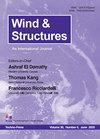The Benefit of Horizontal Photovoltaic Panels in Reducing Wind Loads on a Membrane Roofing System on a Flat Roof
IF 1.9
4区 工程技术
Q3 CONSTRUCTION & BUILDING TECHNOLOGY
引用次数: 5
Abstract
The present paper proposes a measure for improving the wind-resistant performance of photovoltaic systems and mechanically attached single-ply membrane roofing systems installed on flat roofs by combining them together. Mechanically attached single-ply membrane roofing systems are often used in Japan. These roofing systems are often damaged by strong winds, because they are very sensitive to wind action. Recently, photovoltaic (PV) systems placed on flat roofs have become popular. They are also often damaged by strong winds directed onto the underside, which cause large wind forces onto the PV panels. For improving the wind resistance of these systems, we proposed to install PV panels horizontally with gaps between them. Such an installation may decrease the wind forces on the PV panels due to the pressure equalization effect as well as on the waterproofing membrane due to the shielding effect of the PV panels. This paper discusses the validity of such an idea. The pressure on the bottom surface of a PV panel, called the “layer pressure” here, was evaluated by a numerical simulation based on the unsteady Bernoulli equation. In the simulation, the time history of the external pressure coefficients, measured at many points on the roof in a wind tunnel, was employed. It was found that the wind forces, both on the PV panels and on the roofing system, were significantly reduced. The reduction was large near the roof’s corner, where large suction pressures were induced in oblique winds. Thus, the proposed method improved the wind resistance of both systems significantly.水平光伏板在降低平屋顶膜屋面系统风荷载中的作用
本文提出了一种将光伏系统与安装在平屋顶上的机械附着单层膜屋面系统结合起来提高其抗风性能的措施。机械附着的单层膜屋面系统在日本经常使用。这些屋顶系统经常被强风损坏,因为它们对风的作用非常敏感。最近,安装在平屋顶上的光伏(PV)系统变得流行起来。它们也经常被指向底部的强风损坏,这会对光伏电池板造成巨大的风力。为了提高这些系统的抗风能力,我们建议将光伏板水平安装,光伏板之间有空隙。这样的安装可以由于压力均衡作用而降低PV板上的风力,也可以由于PV板的屏蔽作用而降低防水膜上的风力。本文讨论了这一观点的有效性。基于非定常伯努利方程的数值模拟计算了光伏板底面压力,这里称之为“层压”。在模拟中,采用在风洞顶板上多个点测得的外压系数时程。结果发现,光伏板和屋顶系统上的风力都大大减少了。在屋顶的角落附近减小很大,那里在斜风中产生了很大的吸力压力。因此,该方法显著提高了两种系统的抗风能力。
本文章由计算机程序翻译,如有差异,请以英文原文为准。
求助全文
约1分钟内获得全文
求助全文
来源期刊

Wind and Structures
工程技术-工程:土木
CiteScore
2.70
自引率
18.80%
发文量
0
审稿时长
>12 weeks
期刊介绍:
The WIND AND STRUCTURES, An International Journal, aims at: - Major publication channel for research in the general area of wind and structural engineering, - Wider distribution at more affordable subscription rates; - Faster reviewing and publication for manuscripts submitted.
The main theme of the Journal is the wind effects on structures. Areas covered by the journal include:
Wind loads and structural response,
Bluff-body aerodynamics,
Computational method,
Wind tunnel modeling,
Local wind environment,
Codes and regulations,
Wind effects on large scale structures.
 求助内容:
求助内容: 应助结果提醒方式:
应助结果提醒方式:


